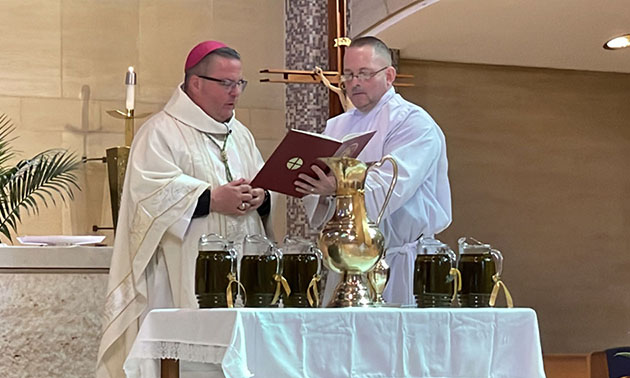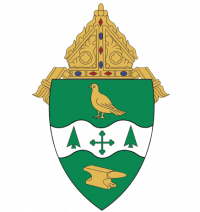
In “The Joy of the Gospel,” Pope Francis spoke about parish life. He wrote, “The parish is the presence of the Church in a given territory, an environment for hearing God’s word, for growth in the Christian life, for dialogue, proclamation, charitable outreach, worship and celebration. In all its activities, the parish encourages and trains its members to be evangelizers. It is a community of communities, a sanctuary where the thirsty come to drink in the midst of their journey, and a center of constant missionary outreach” (No. 28).
As Catholics who belong to a particular parish, we are called to embrace and exude these realities every day. To be Catholic and to be the Church is to be in communion with our brothers and sisters. We are not meant to be an exclusive group. The word “catholic” means broad and all embracing. To be Catholic and to be the Church involves participation without selectivity, prejudice or discrimination, while embodying a sense of mission and looking out for others.
Pope Francis said, “A Church which ‘goes forth’ is a Church whose doors are always open” (No. 46). Pope Saint John XXIII would say that a Church that goes forth is one whose windows are always open to the Holy Spirit.
The responsibility of the bishop is to lead, feed and protect the clergy, religious and faithful in the march to “go forth” in concert with the Holy Spirit, with a sense of hospitality in which the doors of our hearts are open to others. Bishop James McFadden, our first bishop, led this charge with what he called “The March of the Eucharist.” In our present time, we continue that march, strategically employing the resources at our disposal in a very intentional way for the good of the Church.
Since I became your bishop in January of 2021, I have pledged to be transparent and honest. Again and again, I have said to our clergy, religious and faithful that we must live in reality—for we cannot give what we do not have. My predecessor, the late Bishop George Murry, S.J., was committed to having this local Church live in reality. To that end, in 2019 Bishop Murry promulgated a regional plan for the six counties of this diocese that would intentionally address the pastoral needs of the future according to the available clergy resources. Upon my arrival, I embraced that plan and have worked closely with our vicar general, Presbyteral Council, priests, deacons and diocesan pastoral associates to implement it.
The implementation of the regional plan is important not just for strategically employing our priests in the best possible way but also ensuring their spiritual well-being and physical and mental health. Much has been demanded of our priests, and with the help of God’s grace, they continue to respond, serving in multiple parishes and facilitating parish partnerships, collaborations and mergers. We owe these men a debt of gratitude for their flexibility and resiliency.
It is important to note that in 2019, the regional plan projected that there would be 55 active priests in 2025. We have fallen short of that projection because in 2025 we have only 44 active priests, with three retiring in July. While there will be one priesthood ordination this year, there are no priesthood ordinations next year. Therefore, we are becoming even more intentional with the plan that will impact assignments, coverage and Masses.
I am delighted to say that, in addition to welcoming two exceptional extern priests this past year, we will also be welcoming the Rogationist Fathers of the Heart of Jesus who will shepherd one of our parishes in Canton.
At the same time, we are becoming even more intentional about developing a culture of vocations. We now have two vocation directors, Father Chad Johnson and Father William Wainio; the Rogationist Fathers take a fourth vow to pray for vocations; and we have retained the services of Rhonda Grunewald and Vocation Ministry, who spend a day during our upcoming September Clergy Convocation with our priests, educating them on ways to encourage and support vocations in the parish. Subsequently, each parish will be asked to identify a vocation coordinator to help form vocation councils in each parish. Finally, during this same time, we will participate in an initiative promoting devotion and attention to the Sacred Heart of Jesus—the source of all vocations.
In his recently released Encyclical Letter, “He Loved Us,” Pope Francis spoke about the power of the heart. He wrote, “It is only by starting from the heart that our communities will succeed in uniting and reconciling differing minds and wills, so that the Spirit can guide us in unity as brothers and sisters” (No. 28).
Together, let us continue the march into the future, living in reality and seeking to embrace the path of communion, participation and mission. Let us become more intentional in our prayer for more vocations—not just to the priesthood but also religious life and married life. It is in marriage and family where the seeds of religious vocations take root. And together, let us pray, “That all may be one.”
En “La Alegría del Evangelio”, el Papa Francisco habla sobre la vida de la parroquia. Él escribe, “La parroquia es presencia eclesial en el territorio, ámbito de la escucha de la Palabra, del crecimiento de la vida cristiana, del diálogo, del anuncio, de la caridad generosa, de la adoración y la celebración. A través de todas sus actividades, la parroquia alienta y forma a sus miembros para que sean agentes de evangelización. Es comunidad de comunidades, santuario donde los sedientos van a beber para seguir caminando, y centro de constante envío misionero .” (No. 28)
Como católicos que pertenecemos a una parroquia en particular, estamos llamados a abrazar y exudar estas realidades cada día. Ser católico y ser Iglesia es estar en comunión con nuestros hermanos y hermanas. No estamos destinados a ser un grupo excluyente. La palabra “católico” significa amplio y abarcador. Ser católico y ser Iglesia implica participar sin selectividad, prejuicios ni discriminación, encarnando un sentido de misión y velando por los demás.
El Papa Francisco dice, “La Iglesia ‘en salida’ es una Iglesia con las puertas abiertos”. (No. 46). El Papa San Juan XXIII diría que una Iglesia que sale adelante es aquella que tiene las ventanas siempre abiertas al Espíritu Santo.
La responsabilidad del obispo es liderar, alimentar y proteger al clero, los religiosos y a los fieles en la marcha para “salir” en concierto con el Espíritu Santo con un sentido de hospitalidad en el que las puertas de nuestros corazones estén abiertas a los demás. El obispo James McFadden, nuestro primer obispo, encabezó esta carga con lo que llamó “La Marcha de la Eucaristía”. En nuestro tiempo presente, continuamos esa marcha, empleando sistematicamente recursos a nuestra disposición de una manera muy estratégica para el bien de la Iglesia.
Desde que asumí el cargo de obispo en enero de 2021, me he comprometido a ser transparente y honesto. He repetido una y otra vez a nuestro clero, religiosos y fieles que debemos vivir con realismo, pues no podemos dar lo que no tenemos. Mi predecesor, el difunto obispo George Murry, SJ, se comprometió a que esta Iglesia local viviera con realismo. Con ese fin, en 2019, el obispo Murry promulgó un plan regional para los seis condados de esta diócesis que abordaría intencionalmente las necesidades pastorales futuras, según los recursos disponibles del clero. A mi llegada, acogí ese plan y he trabajado en estrecha colaboración con nuestro Vicario General, el Consejo Presbiteral, sacerdotes, diáconos y asociados pastorales diocesanos para implementarlo.
La implementación del plan regional es importante no sólo para emplear estratégicamente a nuestros sacerdotes de la mejor manera posible, sino también para asegurar su bienestar espiritual y su salud física y mental. Se ha exigido mucho a nuestros sacerdotes, y con la ayuda de la gracia de Dios, siguen respondiendo, sirviendo en múltiples parroquias y facilitando alianzas, colaboraciones y fusiones parroquiales. Les debemos una gran gratitud por su flexibilidad y resiliencia.
Es importante destacar que, en 2019, el plan regional proyectó que habría 55 sacerdotes activos en 2025. No hemos alcanzado esa proyección porque en 2025 solo tenemos 44 sacerdotes activos, tres de ellos jubilándose en julio. Si bien habrá una ordenación sacerdotal este año, no habrá ninguna el próximo. Por lo tanto, estamos implementando el plan con mayor precisión, lo cual afectará las asignaciones, la cobertura y las Misas.
Me complace decir que, además de dar la bienvenida a dos excepcionales sacerdotes externos el año pasado, también daremos la bienvenida a los Padres Rogacionistas del Corazón de Jesús que pastorearán una de nuestras parroquias en Cantón.
Al mismo tiempo, nos estamos esforzando aún más por desarrollar una cultura de vocaciones. Ahora contamos con dos directores de vocaciones, el Padre Chad Johnson y el Padre William Wainio; los Padres Rogacionistas hacen un cuarto voto para orar por las vocaciones; y hemos contratado los servicios de Rhonda Grunewald y del Ministerio de Vocaciones, quienes dedicarán un día a nuestros sacerdotes durante nuestra próxima Convocatoria del Clero de septiembre, enseñándoles cómo fomentar y apoyar las vocaciones en la parroquia. Posteriormente, se pedirá a cada parroquia que identifique a un coordinador de vocaciones para que ayude a formar los consejos vocacionales en cada parroquia. Finalmente, durante este mismo periodo, participaremos en una iniciativa que promueve la devoción y la atención al Sagrado Corazón de Jesús, fuente de todas las vocaciones.
En su Carta Encíclica publicada recientemente, “Él nos amó,” el Papa Francisco habla sobre el poder del corazón. Él escribe, “Nuestras comunidades sólo desde el corazón lograrán unir sus inteligencias y voluntades diversas y pacificarlas para que el Espíritu nos guíe como red de hermanos.” (No. 28)
Juntos, continuemos la marcha hacia el futuro, viviendo en la realidad y buscando abrazar el camino de la comunión, la participación y la misión. Seamos más conscientes en nuestra oración por más vocaciones, no solo al sacerdocio, sino también a la vida religiosa y al matrimonio. Es en el matrimonio y la familia donde se arraigan las semillas de las vocaciones religiosas. Y juntos, oremos: “Que todos sean uno”.











